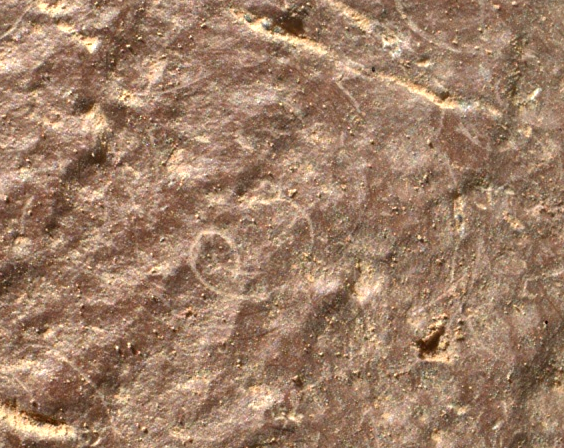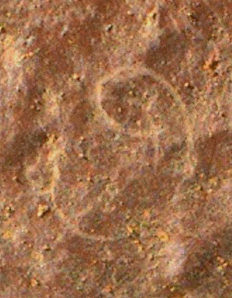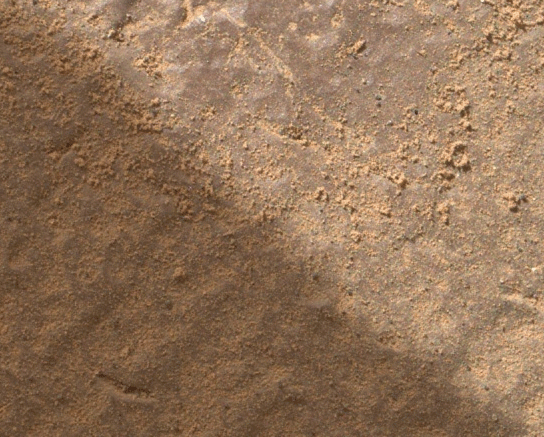It looks like you're using an Ad Blocker.
Please white-list or disable AboveTopSecret.com in your ad-blocking tool.
Thank you.
Some features of ATS will be disabled while you continue to use an ad-blocker.
share:
originally posted by: wildespace
I've changed my mind, those swirls look like tiny mineral veins. Gerald at UMSF agrees:
Those brighter mineralic-looking inclusions/veins/concretions seem to be a little harder than the surrounding soft (inferred from the scratches) rock.
Do we see carbonates (like calcite) for the first time, or is this still a sulfate?
So, these veins aren't literally lying on top of the bedrock, but they are protruding from it slightly. Previous brush events seems to have been over a harder type of bedrock.
Now that's good news, I know there's a number of geologists over there so that's indeed helpful.
I guess that also means we'll soon know more about what could have caused the mineral build-up and to what extent biological processes might have been involved.
a reply to: jeep3r
I have lived around limestone shell formations most of my life and that looks very familiar and biological to me. If Mars was warm up to a few million years ago as some researchers are saying, it may have had time to make the jump to multicellular life. Maybe they are not fossil formations, but that's certainly what they look like. Good find, S&F.
I have lived around limestone shell formations most of my life and that looks very familiar and biological to me. If Mars was warm up to a few million years ago as some researchers are saying, it may have had time to make the jump to multicellular life. Maybe they are not fossil formations, but that's certainly what they look like. Good find, S&F.
edit on 1-8-2016 by openminded2011 because: (no reason given)
Well, sometimes a good thing to do is look at it inverted. Sometimes a scratch will look like a raised thing. So:

I don't know. Looks a lot more like scratches this way.

I don't know. Looks a lot more like scratches this way.
Whether it is algae, plant life or whatever else, it sure looks biological.
Curious to see if this goes the same route when we found the fossilized worm-like structures inside a mars rock - route meaning a) bad reasons popping up trying to explain away the idea that it is biological life and b) a media blackout on the subject.
Curious to see if this goes the same route when we found the fossilized worm-like structures inside a mars rock - route meaning a) bad reasons popping up trying to explain away the idea that it is biological life and b) a media blackout on the subject.
a reply to: Blue Shift
Here goes another view of the main feature:
(rotated, saturation slightly increased, highlight added)
 Source image
Source image
And here a greyscale image with inverted colors:
files.abovetopsecret.com...
For comparison Grypania Spiralis (Earth):

Here go further terrestial comparisons of what might look like scratches but are, in fact, Seaweed fossils (Chinggiskhaania bifurcata):

Also, the general rock surface seen in its entirety is IMO not unlike microbial mats, here an example from Earth:
www.fossilmall.com...
Here goes another view of the main feature:
(rotated, saturation slightly increased, highlight added)

And here a greyscale image with inverted colors:
files.abovetopsecret.com...
For comparison Grypania Spiralis (Earth):

Here go further terrestial comparisons of what might look like scratches but are, in fact, Seaweed fossils (Chinggiskhaania bifurcata):

Also, the general rock surface seen in its entirety is IMO not unlike microbial mats, here an example from Earth:
www.fossilmall.com...
edit on 2-8-2016 by jeep3r because: formatting
a reply to: jeep3r
The resemblance is uncanny.
The only worry I have is if it's another death valley mystery where rocks that seem to move by themselves but was proven to be natural due rain and winds. We know that there are sandstorms on mars and that begs the question...if this is not proof of life could it be proof of ancient rainfall?
The resemblance is uncanny.
The only worry I have is if it's another death valley mystery where rocks that seem to move by themselves but was proven to be natural due rain and winds. We know that there are sandstorms on mars and that begs the question...if this is not proof of life could it be proof of ancient rainfall?
edit on 2-8-2016 by Thecakeisalie because: (no reason given)
a reply to: jeep3r
I took a good look at that image, with the 1 mm scale.
Thanks for that!
I have a comment though -- that rock has large crystals, more like an igneous rock, made from cooling lava, than a sedimentary type rock. I am just a little bummed ... hoping it is not a photo of the same spot as the OP shows, because that would be discouraging. I would love to believe these are biological fossils, but in an igneous rock it becomes more difficult for me to believe.
I took a good look at that image, with the 1 mm scale.
Thanks for that!
I have a comment though -- that rock has large crystals, more like an igneous rock, made from cooling lava, than a sedimentary type rock. I am just a little bummed ... hoping it is not a photo of the same spot as the OP shows, because that would be discouraging. I would love to believe these are biological fossils, but in an igneous rock it becomes more difficult for me to believe.
originally posted by: jeep3r
a reply to: argentus
The stone shown in my previous post (scale reference) is indeed different than the formation in the OP, likely denser and lacking the biological-looking features. The OP image also looks much different than the feldspar crystals imaged in 2014. I guess it'll be up to the geologists to offer alternative interpretations.
I also look forward to what the scientific community and NASA are going to conclude from the available MSL data. The last time something that close to fossils had been imaged was IIRC back at Kirkwood and Eagle crater, where R. Hoover suspected the remains of crinoids and echinosphaerites might have been discovered.
Oops ... okay I 'get it' now. I am no longer discouraged. Thanks ... took me a minute!
originally posted by: Fowlerstoad
Oops ... okay I 'get it' now. I am no longer discouraged. Thanks ... took me a minute!
Actually, the scale reference image from a few posts down on page one is a zinc ore sample from Franklin, New Jersey. It's on the JPL/MAHLI website with additional specs regarding the camera.
I only shared the image to provide a sense of scale. The OP image, however, is from a bedrock target called "Chibia" (see mission update blog) which is of course located at the base of Mount Sharp/Aeolis on Mars.
originally posted by: Spacespider
a reply to: jeep3r
wow..
just wow, looking forward to see where this goes..
Where its going...

Okay, how about this? Predusted (partially) and post-dusted. Find the "fossils" in the predusted image:

(image inverted)

(image inverted)
edit on 2-8-2016 by Blue Shift because: (no reason given)
originally posted by: Blue Shift
Okay, how about this? Predusted and post-dusted. Find the "fossils" in the predusted image:
(image inverted)
Good work, Blue Shift. I'd have to stand corrected if the brushes caused the streaks, although I have not seen the DRT impact the surface like this before, which is ... well, interesting.
Provided that there is no dust layer in the pre-dusted image in all areas (which seems to be the case, see top section) then I guess it has to have been the DRT.
edit on 2-8-2016 by jeep3r because: text
originally posted by: jeep3r
Provided that there is no dust layer in the pre-dusted image in all areas (which seems to be the case, see top section) then I guess it has to have been the DRT.
Believe me, I'm as disappointed as you are. I've spent a lot of time (maybe too much) staring at Mars rock images looking for those very kinds of things, and unfortunately never found anything that I could absolutely say for sure was the real deal.
edit on 2-8-2016 by Blue Shift because:
(no reason given)
a reply to: Blue Shift
Oh well, but we'll never stop looking, I guess, as long as we have a tiny spark of interest left regarding potential life (past or extant) on Mars.
Here's an interesting link regarding the Dust Removal Tool (unfortunately in Russian) showing the device in action on a similar scale. Not at all the same result I'd say and it leaves behind a distinct pattern. But I guess we have to conclude that it can look different under different circumstances.
Well, let's wait for the next potential anomaly!
Oh well, but we'll never stop looking, I guess, as long as we have a tiny spark of interest left regarding potential life (past or extant) on Mars.
Here's an interesting link regarding the Dust Removal Tool (unfortunately in Russian) showing the device in action on a similar scale. Not at all the same result I'd say and it leaves behind a distinct pattern. But I guess we have to conclude that it can look different under different circumstances.
Well, let's wait for the next potential anomaly!
edit on 2-8-2016 by jeep3r because: text
What I like in this kind of threads is their learning value, as we learned that the brushes may have an uneven effect on the rocks and create swirl
effects like those (apparently).
More knowledge makes for better comparisons in the future, so the possibilities of being wrong in the future are getting smaller and smaller.
More knowledge makes for better comparisons in the future, so the possibilities of being wrong in the future are getting smaller and smaller.

new topics
-
'Mass Casualty event' - Attack at Christmas market in Germany
Mainstream News: 5 hours ago -
Search to Resume for MH 370
Disaster Conspiracies: 7 hours ago -
Sue Gray, Sir Keir Starmer's former Chief of Staff, Nominated for Peerage
Regional Politics: 8 hours ago -
Biden Nationalizes Another 50,000+ Student Loans as He Heads for the Exit
US Political Madness: 9 hours ago
top topics
-
'Mass Casualty event' - Attack at Christmas market in Germany
Mainstream News: 5 hours ago, 22 flags -
Biden Nationalizes Another 50,000+ Student Loans as He Heads for the Exit
US Political Madness: 9 hours ago, 7 flags -
Search to Resume for MH 370
Disaster Conspiracies: 7 hours ago, 4 flags -
Sue Gray, Sir Keir Starmer's former Chief of Staff, Nominated for Peerage
Regional Politics: 8 hours ago, 3 flags
active topics
-
My personal experiences and understanding of orbs
Aliens and UFOs • 23 • : DaydreamerX -
'Mass Casualty event' - Attack at Christmas market in Germany
Mainstream News • 57 • : Naftalin -
US Federal Funding set to Expire December 20th. Massive CR on the way.
Mainstream News • 60 • : KrustyKrab -
Biden Nationalizes Another 50,000+ Student Loans as He Heads for the Exit
US Political Madness • 9 • : burntheships -
Post A Funny (T&C Friendly) Pic Part IV: The LOL awakens!
General Chit Chat • 7936 • : baddmove -
Search to Resume for MH 370
Disaster Conspiracies • 4 • : theatreboy -
Drone Shooting Arrest - Walmart Involved
Mainstream News • 38 • : bluesman023 -
Covid....... Again.
Diseases and Pandemics • 33 • : annonentity -
Russias War Against Religion in Ukraine
World War Three • 55 • : Freeborn -
Squirrels becoming predators
Fragile Earth • 36 • : ManSizedSquirrel

